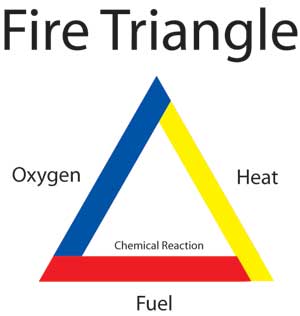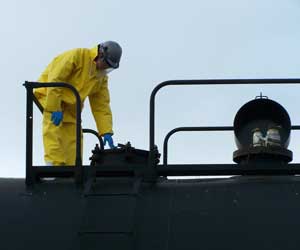Playing It Safe With Methanol






June 21, 2007
BY Jessica Ebert
In terms of methanol safety, 2006 was a year that many in the biodiesel industry would rather forget. A string of methanol fires and biodiesel tank explosions marred the otherwise bountiful growth of the industry. In February, the National Biodiesel Board organized a panel on methanol safety at the organization's national conference. This was the first panel dedicated solely to the topic. In tandem, the Methanol Institute released a primer that discussed the worldwide use and production of biodiesel including guidelines for the safe handling and use of methanol in the manufacturing process.
Overall, biodiesel production is considered a safe process. Handling methanol might be considered an exception to that generality. The simplest of the alcohols, methanol is a colorless, tasteless chemical with a mild but sweet odor. Traditionally called wood spirits or wood alcohol because it can be made through the pyrolysis of wood, methanol is the fuel of choice for drag racing, flying model airplanes, and until late 2005 (when ethanol took its place), for Indy Racing League cars because it performs better, emits fewer emissions and is less flammable than gasoline. Methanol is primarily used as a solvent in paint strippers and antifreeze, and as a material used in the synthesis of dyes, resins and perfumes.
However, along with its many beneficial attributes, methanol is a volatile, flammable poison that burns with a nearly invisible flame. The very same chemical properties that make it an indispensable solvent also elicit a "3" out of "4" fire hazard rating from the National Fire Prevention Association (NFPA). A rating of 3 is given to all materials that are flammable, volatile or explosive at normal temperatures and pressures. "With all the plants that are being built now-at all levels of competence-the general awareness of methanol has come to the front of the stage," says Larry Sullivan, chief technology officer for Kreido Biofuels Inc., who chaired the methanol safety panel at this year's National Biodiesel Conference. "Biodiesel is more and more in the news and regulatory people, whose job is safety, are becoming more aware."
The Simplest Alcohol
Transesterification is the initial chemical reaction in biodiesel production. The reactants in this early step in the process include vegetable oils, a basic catalyst, sodium or potassium hydroxide, and an alcohol, usually methanol. Vegetable oils are esters of fatty acids and glycerol. The fatty acid is the useful part for the production of fuel. Methanol is added to tweeze the fatty acids from glycerol. It replaces the glycerol component of the oil resulting in a methyl ester. Biodiesel in its final form is essentially a slew of purified methyl esters. From a chemistry point of view, any alcohol can be used in the reaction. From a monetary standpoint, however, methanol is No. 1. "Economics largely drive the use of methanol," says John Mostek a chemical engineer with Renewable Energy Group Inc. (REG). "It's the most economical alcohol to use."
The storage and handling of methanol demands respect as its flashpoint, or ignition temperature, is 54 degrees Fahrenheit. To that end, REG takes a three-pronged approach to fire prevention and suppression in its biodiesel plants. Beginning in the rail unload area outside of the plant, where cylindrical tanks on wheels roll in carrying up to 25,000 gallons of methanol, several precautions are taken to prevent and-in the event of an accident-to contain spills, fires and explosions. First, the methanol is pumped from the rail transport car into a storage tank, one of many scattered over the tank farm, which is a series of staging units used to store the raw materials used in the transesterification process and the finished products of biodiesel production. Methanol stored on the tank farm is given the star treatment. "We store methanol in its own spill containment area," Mostek explains. "There's an earthen dike berm built up around the storage tank area so that if there was ever a leak or rupture of a tank then it would be contained in its own area separate from the other tanks."
Dealing with the liquid form of methanol is only one issue when it comes to methanol safety. The alcohol's tendency to form vapors is of even greater concern because the vapors are more flammable than the liquid. To minimize the formation of vapors in a tank, the extra air space is filled with nitrogen gas. "We keep a positive pressure of nitrogen in that space," he explains. "As the tank fills with methanol it displaces some of that nitrogen and as it empties we fill in with additional nitrogen to always maintain an inert atmosphere."
The use of nitrogen blankets in biodiesel production was also a session topic at the National Biodiesel Conference. Lynn Mead, applications consultant for Praxair Inc., an industrial gas provider, presented in the session and explained that nitrogen is an inert gas that is nonflammable and noncombustible. Mead says three factors must align for a fire to start: a source of ignition, which could be as seemingly insignificant as a spark from a hammer hitting the head of a nail; a source of fuel, including fuel vapors; and oxygen or some other oxidizer. These combustion requirements can be visualized as a triangle, suggesting that preventing a fire is as simple as eliminating one leg of that triangle. In the case of a nitrogen blanket, the gas effectively eliminates the oxidizer portion of the combustion triangle by taking up the available air space in a tank.
The benefits don't end there. "A nitrogen blanket reduces oxidation, hygroscopicity and hydrolysis," Mead says. If not held in check, these factors can ultimately lower the quality of biodiesel, he explains. "The whole issue originally was to stop things like fires but with a nitrogen blanket you also get the added bonus of a lot better product," he says. Mead has worked with more than 20 different biodiesel plants on various issues. So far, 17 plants in his coverage area are using nitrogen blankets. In addition, his conference presentation sparked numerous questions including, "How soon can you come visit my facility?" Mead recalls.
Nitrogen blanketing is not a new process, Mostek says. He explains that REG has been using it since 2002. "It's a time-tested and accepted method for preventing fires," he says. For that reason, nitrogen is not only used to blanket storage tanks in an REG designed or built facility, it is also used in all of the process tanks within the plant that have methanol in the liquid stream. In addition, methanol detectors are installed that sniff out vapors. In the event of a methanol vapor leak, the devices warn the system and automatically shut the plant down.
Besides breaking the oxygen leg of the fire triangle, REG's methanol safety measures include eliminating ignition sources-the second prong in the company's overall safety scheme. All the wiring that powers electrical pumps, motors, instruments and other devices must be nonsparking and the equipment explosion proof. This is something that's actually required by law, explains Jim Blair, CEO of CoreVentures Renewable Fuels. "From the process side, the part of the facility where the transesterification occurs by law is required to be what is referred to as 'intrinsically safe'," he says. Tools must be coated with a material like beryllium that prevents sparking, and all motors and electrical wiring must be nonsparking.
Blair also advocates the use of nitrogen blankets. "We have nitrogen blankets on our soybean oil," he says. "We have nitrogen blankets on our biodiesel. We have nitrogen blankets on our methanol. It's more costly to do business but how do you place a value on safety?" In addition, Blair recommends high levels of safety training for employees. "Our employees are brought in six weeks prior to start-up and it's a minimum of four weeks of safety training-just safety training-not production operation training," he says. "It's all about safety. It's all about people being aware of what they're doing."
Safety Standards
Not every biodiesel plant goes to these lengths when it comes to fire prevention. This is due in part to the upfront cost of installing nitrogen blankets as well as the continued operation expense. There's also not a single set of methanol safety standards that biodiesel producers are forced to follow. A few of the codes that many producers comply with are the International Building Code, certain standards recommended by the NFPA, specifically NFPA 30, which outlines storage and process handling standards for flammable and combustible liquids, and standards required by various insurance companies.
"One of the most critical things in the design process is determining who the owners' insurance representative is," says Michael Reese, vice president in charge of the fire sprinkler division of NewMech Cos. Inc., an engineering, procurement and construction firm. "The requirements from one insurance company to another are drastically different."
FM Global is one of the few insurance companies willing to cover biodiesel plants at this time, and it's considered one of the most stringent in terms of its methanol safety standards. "The position that we've always taken is that if a plant is built to FM standards then virtually every insurance company will accept the fire protection," says David McKinney, industry practice specialist with the Biofuels Practice Group, a division of the insurance brokerage firm IMA. "If a plant is built to only the NFPA standards, however, not every insurance company will accept those standards."
FM Global has a separate testing facility in Rhode Island where engineers run fire tests that become the basis for the company's standards, McKinney says. One recommendation is that methanol is stored outside a plant at specific distances from the main building, based on the size of the tank. Additionally, FM recommends that the process part of the facility be protected with a sprinkler system and that a drainage system be designed to carry liquids away from other process equipment, because the main focus for insurance companies is minimizing property damage and controlling loss, McKinney says. "It's not so much about trying to put out a fire as it is about protecting the equipment around it from getting damaged in the fire," McKinney explains. "And water has a cooling effect on equipment."
Water also has a suppression effect on fire, which is the third prong in the approach that REG takes to safely use methanol. The sprinkler systems that Mostek describes are purely water emitting. Some biodiesel production facilities, on the other hand, install sprinkler systems that emit aqueous film forming foam with alcohol resistance (AFFF/AR) to layer and suffocate methanol flames. However, "foam, while effective on a two-dimensional fire is practically useless on a three-dimensional fire," McKinney cautions.
The Three-Pronged Approach
Together, nitrogen blankets and methanol vapor detectors, explosion-proof equipment, and sprinkler systems form an integrated, efficient and what is arguably the most comprehensive approach to methanol fire prevention and suppression. It's an approach that some say should be the standard for the biodiesel industry. "We're trying to handle and prevent anything from happening in the first place but should it happen then we're taking the precautions to minimize any negative effects of an event," Mostek explains. "In a young industry, the tendency for some may be to do things as cheaply as possible. If that comes at the expense of safety … it'll get you in the long-term."
Jessica Ebert is a Biodiesel Magazine staff writer. Reach her at jebert@bbibiofuels.com or (701) 746-8385.
Overall, biodiesel production is considered a safe process. Handling methanol might be considered an exception to that generality. The simplest of the alcohols, methanol is a colorless, tasteless chemical with a mild but sweet odor. Traditionally called wood spirits or wood alcohol because it can be made through the pyrolysis of wood, methanol is the fuel of choice for drag racing, flying model airplanes, and until late 2005 (when ethanol took its place), for Indy Racing League cars because it performs better, emits fewer emissions and is less flammable than gasoline. Methanol is primarily used as a solvent in paint strippers and antifreeze, and as a material used in the synthesis of dyes, resins and perfumes.
However, along with its many beneficial attributes, methanol is a volatile, flammable poison that burns with a nearly invisible flame. The very same chemical properties that make it an indispensable solvent also elicit a "3" out of "4" fire hazard rating from the National Fire Prevention Association (NFPA). A rating of 3 is given to all materials that are flammable, volatile or explosive at normal temperatures and pressures. "With all the plants that are being built now-at all levels of competence-the general awareness of methanol has come to the front of the stage," says Larry Sullivan, chief technology officer for Kreido Biofuels Inc., who chaired the methanol safety panel at this year's National Biodiesel Conference. "Biodiesel is more and more in the news and regulatory people, whose job is safety, are becoming more aware."
The Simplest Alcohol
Transesterification is the initial chemical reaction in biodiesel production. The reactants in this early step in the process include vegetable oils, a basic catalyst, sodium or potassium hydroxide, and an alcohol, usually methanol. Vegetable oils are esters of fatty acids and glycerol. The fatty acid is the useful part for the production of fuel. Methanol is added to tweeze the fatty acids from glycerol. It replaces the glycerol component of the oil resulting in a methyl ester. Biodiesel in its final form is essentially a slew of purified methyl esters. From a chemistry point of view, any alcohol can be used in the reaction. From a monetary standpoint, however, methanol is No. 1. "Economics largely drive the use of methanol," says John Mostek a chemical engineer with Renewable Energy Group Inc. (REG). "It's the most economical alcohol to use."
The storage and handling of methanol demands respect as its flashpoint, or ignition temperature, is 54 degrees Fahrenheit. To that end, REG takes a three-pronged approach to fire prevention and suppression in its biodiesel plants. Beginning in the rail unload area outside of the plant, where cylindrical tanks on wheels roll in carrying up to 25,000 gallons of methanol, several precautions are taken to prevent and-in the event of an accident-to contain spills, fires and explosions. First, the methanol is pumped from the rail transport car into a storage tank, one of many scattered over the tank farm, which is a series of staging units used to store the raw materials used in the transesterification process and the finished products of biodiesel production. Methanol stored on the tank farm is given the star treatment. "We store methanol in its own spill containment area," Mostek explains. "There's an earthen dike berm built up around the storage tank area so that if there was ever a leak or rupture of a tank then it would be contained in its own area separate from the other tanks."
Dealing with the liquid form of methanol is only one issue when it comes to methanol safety. The alcohol's tendency to form vapors is of even greater concern because the vapors are more flammable than the liquid. To minimize the formation of vapors in a tank, the extra air space is filled with nitrogen gas. "We keep a positive pressure of nitrogen in that space," he explains. "As the tank fills with methanol it displaces some of that nitrogen and as it empties we fill in with additional nitrogen to always maintain an inert atmosphere."
The use of nitrogen blankets in biodiesel production was also a session topic at the National Biodiesel Conference. Lynn Mead, applications consultant for Praxair Inc., an industrial gas provider, presented in the session and explained that nitrogen is an inert gas that is nonflammable and noncombustible. Mead says three factors must align for a fire to start: a source of ignition, which could be as seemingly insignificant as a spark from a hammer hitting the head of a nail; a source of fuel, including fuel vapors; and oxygen or some other oxidizer. These combustion requirements can be visualized as a triangle, suggesting that preventing a fire is as simple as eliminating one leg of that triangle. In the case of a nitrogen blanket, the gas effectively eliminates the oxidizer portion of the combustion triangle by taking up the available air space in a tank.
The benefits don't end there. "A nitrogen blanket reduces oxidation, hygroscopicity and hydrolysis," Mead says. If not held in check, these factors can ultimately lower the quality of biodiesel, he explains. "The whole issue originally was to stop things like fires but with a nitrogen blanket you also get the added bonus of a lot better product," he says. Mead has worked with more than 20 different biodiesel plants on various issues. So far, 17 plants in his coverage area are using nitrogen blankets. In addition, his conference presentation sparked numerous questions including, "How soon can you come visit my facility?" Mead recalls.
Nitrogen blanketing is not a new process, Mostek says. He explains that REG has been using it since 2002. "It's a time-tested and accepted method for preventing fires," he says. For that reason, nitrogen is not only used to blanket storage tanks in an REG designed or built facility, it is also used in all of the process tanks within the plant that have methanol in the liquid stream. In addition, methanol detectors are installed that sniff out vapors. In the event of a methanol vapor leak, the devices warn the system and automatically shut the plant down.
Besides breaking the oxygen leg of the fire triangle, REG's methanol safety measures include eliminating ignition sources-the second prong in the company's overall safety scheme. All the wiring that powers electrical pumps, motors, instruments and other devices must be nonsparking and the equipment explosion proof. This is something that's actually required by law, explains Jim Blair, CEO of CoreVentures Renewable Fuels. "From the process side, the part of the facility where the transesterification occurs by law is required to be what is referred to as 'intrinsically safe'," he says. Tools must be coated with a material like beryllium that prevents sparking, and all motors and electrical wiring must be nonsparking.
Blair also advocates the use of nitrogen blankets. "We have nitrogen blankets on our soybean oil," he says. "We have nitrogen blankets on our biodiesel. We have nitrogen blankets on our methanol. It's more costly to do business but how do you place a value on safety?" In addition, Blair recommends high levels of safety training for employees. "Our employees are brought in six weeks prior to start-up and it's a minimum of four weeks of safety training-just safety training-not production operation training," he says. "It's all about safety. It's all about people being aware of what they're doing."
Safety Standards
Not every biodiesel plant goes to these lengths when it comes to fire prevention. This is due in part to the upfront cost of installing nitrogen blankets as well as the continued operation expense. There's also not a single set of methanol safety standards that biodiesel producers are forced to follow. A few of the codes that many producers comply with are the International Building Code, certain standards recommended by the NFPA, specifically NFPA 30, which outlines storage and process handling standards for flammable and combustible liquids, and standards required by various insurance companies.
"One of the most critical things in the design process is determining who the owners' insurance representative is," says Michael Reese, vice president in charge of the fire sprinkler division of NewMech Cos. Inc., an engineering, procurement and construction firm. "The requirements from one insurance company to another are drastically different."
FM Global is one of the few insurance companies willing to cover biodiesel plants at this time, and it's considered one of the most stringent in terms of its methanol safety standards. "The position that we've always taken is that if a plant is built to FM standards then virtually every insurance company will accept the fire protection," says David McKinney, industry practice specialist with the Biofuels Practice Group, a division of the insurance brokerage firm IMA. "If a plant is built to only the NFPA standards, however, not every insurance company will accept those standards."
FM Global has a separate testing facility in Rhode Island where engineers run fire tests that become the basis for the company's standards, McKinney says. One recommendation is that methanol is stored outside a plant at specific distances from the main building, based on the size of the tank. Additionally, FM recommends that the process part of the facility be protected with a sprinkler system and that a drainage system be designed to carry liquids away from other process equipment, because the main focus for insurance companies is minimizing property damage and controlling loss, McKinney says. "It's not so much about trying to put out a fire as it is about protecting the equipment around it from getting damaged in the fire," McKinney explains. "And water has a cooling effect on equipment."
Water also has a suppression effect on fire, which is the third prong in the approach that REG takes to safely use methanol. The sprinkler systems that Mostek describes are purely water emitting. Some biodiesel production facilities, on the other hand, install sprinkler systems that emit aqueous film forming foam with alcohol resistance (AFFF/AR) to layer and suffocate methanol flames. However, "foam, while effective on a two-dimensional fire is practically useless on a three-dimensional fire," McKinney cautions.
The Three-Pronged Approach
Together, nitrogen blankets and methanol vapor detectors, explosion-proof equipment, and sprinkler systems form an integrated, efficient and what is arguably the most comprehensive approach to methanol fire prevention and suppression. It's an approach that some say should be the standard for the biodiesel industry. "We're trying to handle and prevent anything from happening in the first place but should it happen then we're taking the precautions to minimize any negative effects of an event," Mostek explains. "In a young industry, the tendency for some may be to do things as cheaply as possible. If that comes at the expense of safety … it'll get you in the long-term."
Jessica Ebert is a Biodiesel Magazine staff writer. Reach her at jebert@bbibiofuels.com or (701) 746-8385.
Advertisement
Advertisement
Upcoming Events





